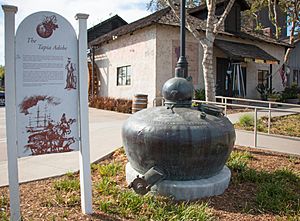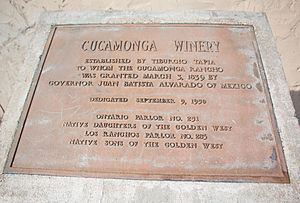Tapia Adobe facts for kids
Quick facts for kids Tapia Adobe |
|
|---|---|

Tapia Adobe Marker Sign
|
|
| Location | 8916 Foothill Blvd, Cucamonga, California |
| Area | 13,000-acre |
| Built | 1839 |
| Architect | Tiburcio Tapia |
| Architectural style(s) | Adobe bricks |
| Designated | October 9, 1939. |
| Reference no. | 360 |
| Lua error in Module:Location_map at line 420: attempt to index field 'wikibase' (a nil value). | |

The Tapia Adobe was the home of Tiburcio Tapia (1789–1845). Tiburcio Tapia was an important person in Mexican California. He was a soldier, a leader, a business owner, and a ranch owner. His home was in what is now Cucamonga, California.
The Tapia Adobe home was named a California Historic Landmark (No. 360) on October 9, 1939. This means it is a special place that helps us remember history. Tiburcio Tapia received the land for his home and the Rancho Cucamonga area in 1839. This land was a huge gift, about 13,045 acres, from the Mexican government. It was given by the Mexican governor, Juan Bautista Alvarado. This large piece of land is now part of Rancho Cucamonga and Upland.
Rancho Cucamonga's History
Tiburcio Tapia started a winery in Cucamonga. It was the very first winery in California! It was also the second oldest in the entire United States.
Tapia's family sold Rancho de Cucamonga in 1858. After that, the big adobe home was left empty. Adobe homes are built with sun-dried mud bricks. Without a good roof, these homes can get damaged very quickly. Even with a good roof, they need a lot of care. Over time, the Tapia Adobe slowly returned to the earth.
Later, a man named John Rains bought Rancho Cucamonga. In 1860, John Rains and his wife built a new home. They called it Casa de Rancho Cucamonga. This new home has been fixed up and is now a National Register of Historic Places.
In 1871, a banker named Isaias W. Hellman and some business partners bought the 13,000-acre Rancho Cucamonga. Hellman and his partners, including a former governor named John Downey, divided the land into smaller pieces. Hellman continued to make wine from the famous vineyards in Cucamonga. Tapia had first planted grapes in 1839. John Rains had made the vineyard even bigger, to 150 acres, by 1859.
Train service started in the area in 1887. Later, the land was divided into three towns: Cucamonga, Etiwanda, and Alta Loma. These three towns joined together to form the city of Rancho Cucamonga in 1977. The northern part of another area, Chaffey's Ontario colony, became the city of Upland in 1906.
The Tapia Family
The Tapia family has a long history in California.
- Felipe Santiago Tapia (1745–1811) was a soldier. He was part of the de Anza Expedition, an important journey in early California history. A street in San Francisco, Tapia Drive, is named after him.
- Jose Bartolome Tapia (1766–1824) was Felipe Santiago Tapia's son. He was the oldest of nine children. He was given land for a place called Rancho Topanga Malibu Sequit.
- Tiburcio Tapia (1789–1845) was Jose Bartolome Tapia's son. He was given the land for Rancho Cucamonga. He was also the Mayor of Los Angeles in 1830, 1839, and 1840. He married María Tomasa Valdéz.
- Maria Merced Tapia de Prudhomme was Tiburcio Tapia's daughter. She married Leon Victor Prudhomme.
Historical Markers
There are special signs, called markers, that tell us about the history of the Tapia Adobe and the Cucamonga Winery.
A marker at the Tapia Adobe site says:
- In 1839, Governor Juan Alvarado gave a 13,000-acre piece of land called Cucamonga to Tiburcio Tapia. He was a former soldier, a well-known business owner, and a leader in Los Angeles. About half a mile west of this sign, Tapia immediately built an adobe house. He used Native American workers to build it on a good spot on Red Hill. The large adobe house was left empty in 1858 when Tapia's family sold the ranch. The adobe soon fell apart and returned to the earth. This sign is on land that was once part of Tapia's ranch.
A marker at the Cucamonga Winery site says:
- This winery was started by Tiburcio Tapia. He was given the Cucamonga Rancho on March 3, 1839, by Governor Juan Bautista Alvarado of Mexico.

